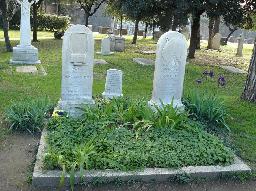Severn, Joseph |
| PAINTER, DIPLOMAT (ENGLAND) |
|
BORN 7 Dec 1793, London: Hoxton - DIED 3 Aug 1879, Roma, Lazio GRAVE LOCATION Roma, Lazio: Cimitero Acattolico, Via Caio Cestio 6 (Parte Antica, Plot 65 (gravestone 32)) |
|
Joseph Severn was the son of a music teacher. He was apprenticed to the engraver William Bond when he was fourteen years old. In 1815 he entered the schools of the Royal Academy. He exhibited "Hermia and Helena" in 1819 and also in 1819 he received the gold medal of the Royal Academy for "Una and the Red Cross Knight in the Cave of Despair". With the medal came a studentship that allowed him to travel for three years. In 1819 he probably had an illegitimate son, Henry. On 17 September 1820 he left for Rome together with the poet John Keats. He had probably first met Keats in 1816 and painted him before or in 1819. Keats was travelling to Rome for his health and Severn had agreed to accompany him. They arrived in Naples on 21 October and travelled to Rome in November. There they lived at 26 Piazza di Spagna. His letters to his friends in England describe the last months of Keats' life. Severn took care of Keats until he died on 23 February 1821. During the 1820s and 1830s he worked successfully as a painter in Rome. He painted miniatures, landscapes, frescoes and other pieces. In 1828 he married Elizabeth Montgomerie, the illegitimate daughter of Archibald, Lord Montgomerie (1773-1814). They had seven children, aming them the painter Arthur Severn. During his time in Rome he was visited by many at his apartment in the Via di San Isidoro. In 1841 he returned to England but there he found it hard to make a living from painting. In 1853 he was forced to flee to Jersey for his creditors. In 1861 he became the British Consul in Rome. He was often able to help British visitors but he didn't always follow the rules set by the Foreign Office. He seemed much younger than he was and he held his post until his retirement in 1872. He continued to live in Rome and after his death in 1879 he was buried in the new part of the Cimitero Acattolico. On 13 February 1882 his remains were transferred to the old part of the cemetery and buried next to those of Keats. Related persons • met Gibson, John • was a friend of Keats, John • painted Keats, John • has a connection with Rothwell, Richard • met Ruskin, John • knew Shelley, Mary • painted Shelley, Percy Bysshe • knew Trelawny, Edward John |
| Images |





